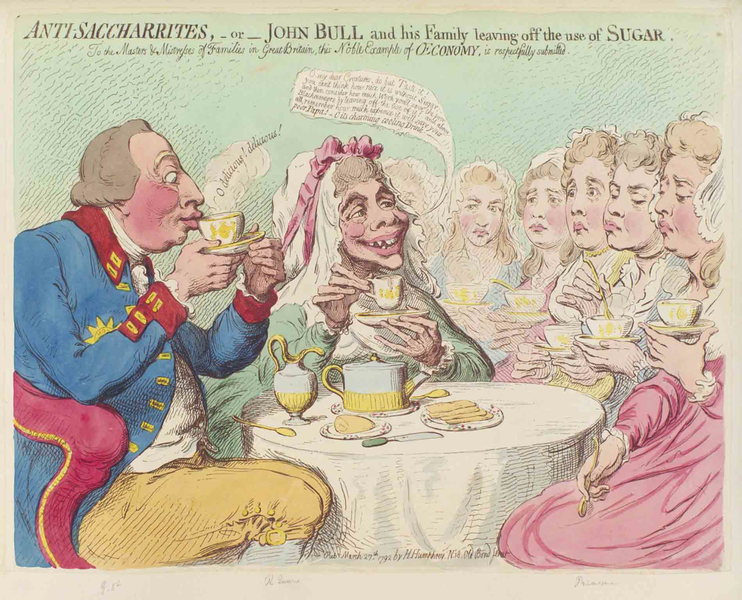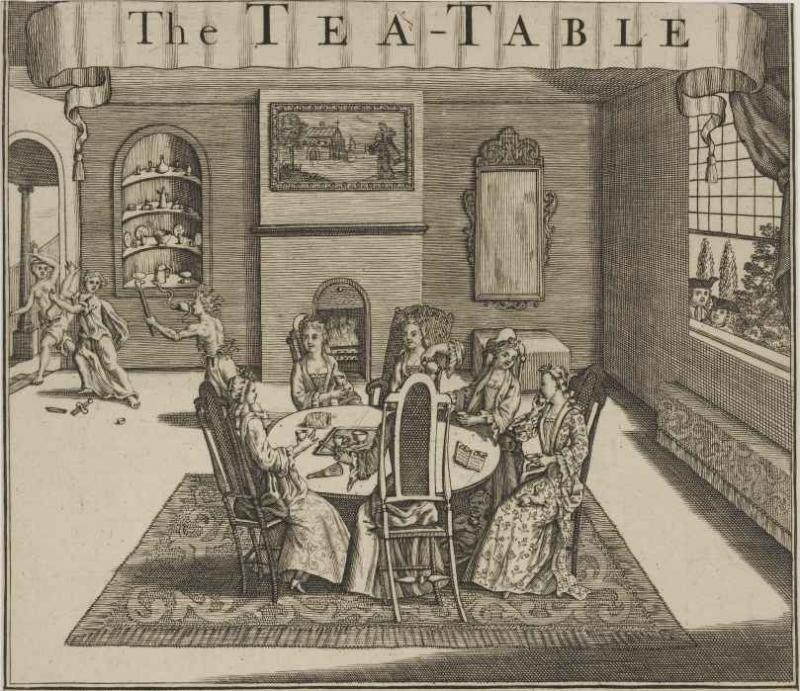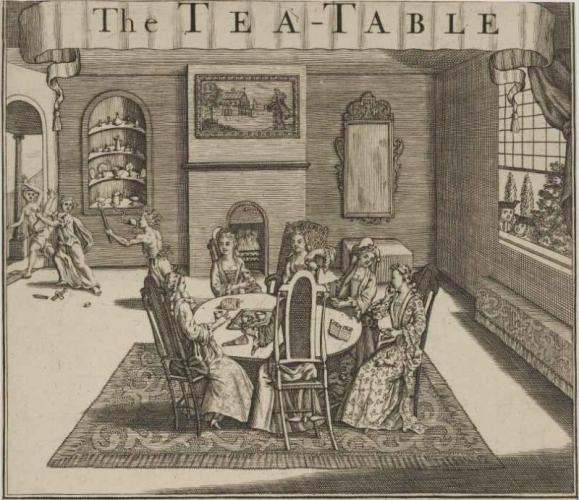Abstract
In the eighteenth century, sugar, once a luxury item, became more affordable and was used as a sweetener for tea and baked goods at a time when the tea-table was coded as domestic and feminine. The production of sugar was closely linked to transatlantic slavery, as documented in James Grainger's georgic poem The Sugar Cane (1764). The 1790s saw a major sugar boycott, in which female consumers participated and which aimed at the emancipation of slaves. Information about slavery in the West Indies was distributed through pamphlets, satirical prints, petitions, and objects.
Keywords
Sugar, which had been a luxury good up to the mid-seventeenth century, became more affordable and more common in the eighteenth century. It was linked to the sociable consumption of tea, sweet pastries, rum, and punch. As a popular consumer item, West Indian sugar, which was produced with slave labour, became the target of a boycott promoted by the 1790s ‘Anti-Saccharite campaign’.
The history of sugar made from sugar cane goes back a long way.1 Sugar is mentioned in Indian literature around 400–350 BC (Mintz 19). The cultivation of sugar cane and the production of sugar were introduced through Arabs to Southern Europe and North Africa, then later moved to Spain's and Portugal's Atlantic islands, and eventually, in the seventeenth century, to the British and French West Indies. Besides tobacco, chocolate, and spices, sugar was one of several New World crops that were imported into Britain on a large scale, where home consumption grew from 4.01 lb per capita in 1698-99 to 23.02 lb in 1770-1779.2 Sugar, a labour-intensive crop, was produced in the colonies with extensive use of slave labour. The historian of sugar Sidney Mintz has described sugar plantations as ‘a synthesis of field and factory’ (47). The work was hard and dangerous: sugar cane was grown, cut, and ground, then the juice was boiled and potted at the boiling house in long shifts that went into or even through the night. One important document for the eighteenth-century cultivation of sugar in the Caribbean is the Scottish slave-owner James Grainger's four-book georgic poem The Sugar Cane (1764), a detailed manual of how to run a plantation, grow sugar cane, boil sugar, and keep slaves, as the introductory lines set out to explain:
‘WHAT soil the Cane affects; what care demands;
Beneath what signs to plant; what ills await;
How the hot nectar best to christallize;
And Afric’s sable progeny to treat:
A Muse, that long hath wander'd in the groves
Of myrtle-indolence, attempts to sing.‘3
Grainger's poem, which draws heavily on heroic diction (e.g. ‘nectar’ for ‘sugar’) and is kept in blank verse, shows an awareness of the slaves' plight but does not aim to question the plantation system.
- 1. Sidney Mintz, Sweetness and Power: The Place of Sugar in Modern History (London: Penguin, 1978), p. 19-73.
- 2. Jon Stobart, Sugar and Spice: Grocers and Groceries in Provincial England, 1650-1830 (Oxford: Oxford University Press, 2013), p. 49; Carole Shammas, ‘Changes in English and Anglo-American Consumption from 1550 to 1800‘ in John Brewer and Roy Porter (eds), Consumption and the World of Goods (London: Routledge, 1993), p. 177-205, p. 182.
- 3. James Grainger, The Sugar Cane: A Poem. In Four Books. With Notes (London: Dodsley, 1764), p. 3; book I, ll. 1-6.
As sugar became ever more affordable in Britain, it played an important role in what Clare Midgley has called ‘new rituals of sociability’ in the eighteenth-century British home, which were related to tea and the tea-table.4 If, prior to its popularisation, sugar had also been used as medicine, spice, decoration, or to preserve food, in the eighteenth century, sugar's primary use as a sweetener was firmly established. The rising consumption of sugar together with tea is closely linked to material culture, to the fashion of china. The import of china, first brought from Asia, later locally produced in Britain, was accompanied by the importation of tea, in which the East India Company played a decisive role.5 Sugar became ‘the inseparable companion of tea’,6 while pastries and other sweets, likewise treacle, entered the regular British diet (Mintz 117-118). The domestic, woman-dominated tea-table, which became a counterpoint to the male coffee-house, is a cultural icon that resonates in several ways. A fair number of poems and essays pay tribute to this new substance and the rituals surrounding it.7 Peter Motteux's ‘Poem upon Tea‘ (1712) envisions a community of classical gods and goddesses, a kind of Olympic tea-table, where Gods are refreshed by this new ‘nectar’, whose properties are enumerated.8
The British tea-table could stand for polite and refined domestic sociability, a place for the immediate circle of the family, who participated in the drinking of tea. It could also be at the centre of middle-class families' social entertaining in their home, involving a circle of visitors, who were served tea (with sugar) and sweet pastries (Midgley 46). The female tea-table also attracted satirical descriptions as a site of unnecessary exotic luxuries, illicit sexuality, scandal mongering, and excess. One print, presumably dating from around 1720, shows a tea-table with six women engaged in conversation, while two men, apparently excluded, peek through the window.9
A satirical poem below the image attacks the institution of the female tea-table, accusing its participants of ‘slander’ and malicious gossip. Sugar was also part of a male sociable ritual, the consumption (and sometimes also preparation) of punch, a drink made up from sugar, spices, rum, fruit, and water.10
- 4. Clare Midgley, Feminism and Empire: Women Activists in Imperial Britain, 1790-1865 (London: Routledge, 2007), p.46.
- 5. Erika Rappaport, A Thirst for Empire: How Tea Shaped the Modern World (Princeton: Princeton University Press, 2017), p. 405.
- 6. Duncan Forbes, Some Considerations on the Present State of Scotland (Edinburgh: Sands, 1744), p. 7; quoted in Mintz, p. 114.
- 7. Markman Ellis (ed.), Literary Representations of Tea and the Tea-Table, vol. 1 of Tea and the Tea-Table in Eighteenth-Century England, 4 vols, Markman Ellis, Richard Coulton, Matthew Mauger and Ben Dew (eds) (London: Pickering & Chatto, 2010). The database Eighteenth Century Collections Online also contains relevant texts.
- 8. Peter Motteux, ‘A Poem upon Tea‘ (London: Tonson, 1712) in Ellis (ed.), Literary Representations, p. 37-48.
- 9. The poem and its date of publication are discussed in Markman Ellis, ‘The Tea-table, Women and Gossip in Early Eighteenth-Century Britain‘ in Valérie Capdeville and Alain Kerhervé (eds), British Sociability in the Long Eighteenth Century: Challenging the Anglo-French Connection (Suffolk: Boydell & Brewer, 2019), p. 69-87, p. 83-85. See also Markman Ellis, Richard Coulton, and Matthew Mauger (eds), Empire of Tea: The Asian Leaf that Conquered the World (London: Reaktion, 2015), p. 87.
- 10. Karen Harvey, ‘Barbarity in a Teacup? Punch, Domesticity and Gender in the Eighteenth Century‘, Journal of Design History (vol. 21, no. 3, 2008), p. 205-221.
Anti-slavery sentiment was growing in Britain towards the end of the eighteenth century. Combining political statement with fashionable sentiment, William Cowper's poem ‘Pity for Poor Africans‘ (1788), which explicitly links the slave trade and the institution of slavery to sugar, vented popular feelings. The 1790s saw several attempts, led by William Wilberforce, to introduce a bill to abolish the slave trade. If petitioning was one major form of protest on the abolitionists' side, there was yet another, in which women, who decided on their family's consumption of food, played a considerable role: the so-called Anti-Saccharite campaign, which began to take off in the 1780s and gained momentum in 1791 after Parliament had rejected the abolition bill. Central to this campaign was William Fox's pamphlet An Address to the People of Great Britain, on the Utility of Refraining from the Use of West India Sugar and Rum, which was frequently reprinted and achieved a large circulation.11
- 11. Charlotte Sussman, ‘Women and the Politics of Sugar‘, Representations (vol. 48, 1994), p. 48-69, p.51.
It was a call to boycott slave-grown sugar. Fox appealed to the consumers' moral awareness: ‘The slave-dealer, the slave-holder, and the slave-driver, are virtually the agents of the consumer, and may be considered as employed and hired by him to procure the commodity.’ And: ‘[...] in every pound of sugar used, we may be considered as consuming one ounce of human flesh’.William Fox, An Address to the People of Great Britain, on the Utility of Refraining from the Use of West India Sugar and Rum (London: 1791), reprinted in Timothy Morton (ed.), Radical Food: The Culture and Politics of Eating and Drinking 1790-1820, vol. 1 (London: Routledge, 2004), p. 33-40, p. 34, 35. For the representation of bodies, see Sussman, p. 52. It was estimated by contemporaries that, as a consequence of the campaign, about 400,000 men, women, and children abstained from sugar (Stobart 46). Consumers were alerted to the brutality of the sugar production through satire, too. James Gillray's print ‘Barbarities in the West Indias‘ (1791) depicts a gruesome scene in a boiling house on a sugar plantation, where, as the caption explains, a slave, too sick to work, had been thrown into a pot of boiling sugar juice.
Although the victim was eventually taken out, the print conveys the idea that the slave's body metaphorically melts into the sugar and ends up on British tables, that British sugar consumption maims and kills slaves. Another of Gillray's prints, ‘Anti-Saccharites, or John Bull and his Family Leaving Off the Use of Sugar‘ (1792), shows Queen Charlotte advising the sceptical-looking princesses to have their tea without sugar. Since she employs a financial, not an ethical argument, the print pokes fun at the frugality she famously practised. It also emphasises women's activities within the abolitionist movement.
If some consumers turned to East India sugar, others abstained entirely because it was impossible to tell the origin of the produce as it was on sale. Abolitionist china helped to underscore the message: Wedgwood produced not only medallions but also plates bearing the inscription ‘Am I not a Man and a Brother?’ with an image of a kneeling slave in chains. The sociable drinkers of tea were thus reminded of the injustices of enjoying sugar. The sociability created by the tea-table continued, yet many tea-drinkers effectively got rid of one of the central ingredients of afternoon tea: sugar. Slavery in the British Empire was eventually abolished in the wake of a bill that was passed in the British Parliament in 1833.
Share
Further Reading
Ellis, Markman , Coulton, Richard , Mauger, Matthew and Dew, Ben (eds.), Tea and the Tea-Table in Eighteenth-Century England, 4 vols (London: Pickering & Chatto, 2010).
Harvey, Karen, ‘Barbarity in a Teacup? Punch, Domesticity and Gender in the Eighteenth Century‘, Journal of Design History (vol. 21, n° 3, 2008), p. 205-221.
Kowaleski-Wallace, Elizabeth, Consuming Subjects: Women, Shopping, and Business in the Eighteenth Century (New York: Columbia University Press, 1997).
Midgley, Clare, Feminism and Empire: Women Activists in Imperial Britain, 1790-1865 (London: Routledge, 2007).
Mintz, Sidney, Sweetness and Power: The Place of Sugar in Modern History (London: Penguin, 1978).
Rappaport, Erika, A Thirst for Empire: How Tea Shaped the Modern World (Princeton: Princeton University Press, 2017).
Stobart, Jon, Sugar and Spice: Grocers and Groceries in Provincial England, 1650-1830 (Oxford: Oxford University Press, 2013).
Sussman, Charlotte, ‘Women and the Politics of Sugar‘, Representations (n° 48, 1994), p. 48-69.


![James Gillray, 'Barbarities in the West Indias [Indies]', © National Portrait Gallery, London, NPG D12417, 1791.](/sites/default/files/styles/notice_full/public/2024-02/SUGAR%20Barbarities.png?itok=m7fKAdkY)

![James Gillray, 'Barbarities in the West Indias [Indies]', © National Portrait Gallery, London, NPG D12417, 1791.](/sites/default/files/styles/wysiwyg_full/public/2024-02/SUGAR%20Barbarities.png?itok=liYtIExH)